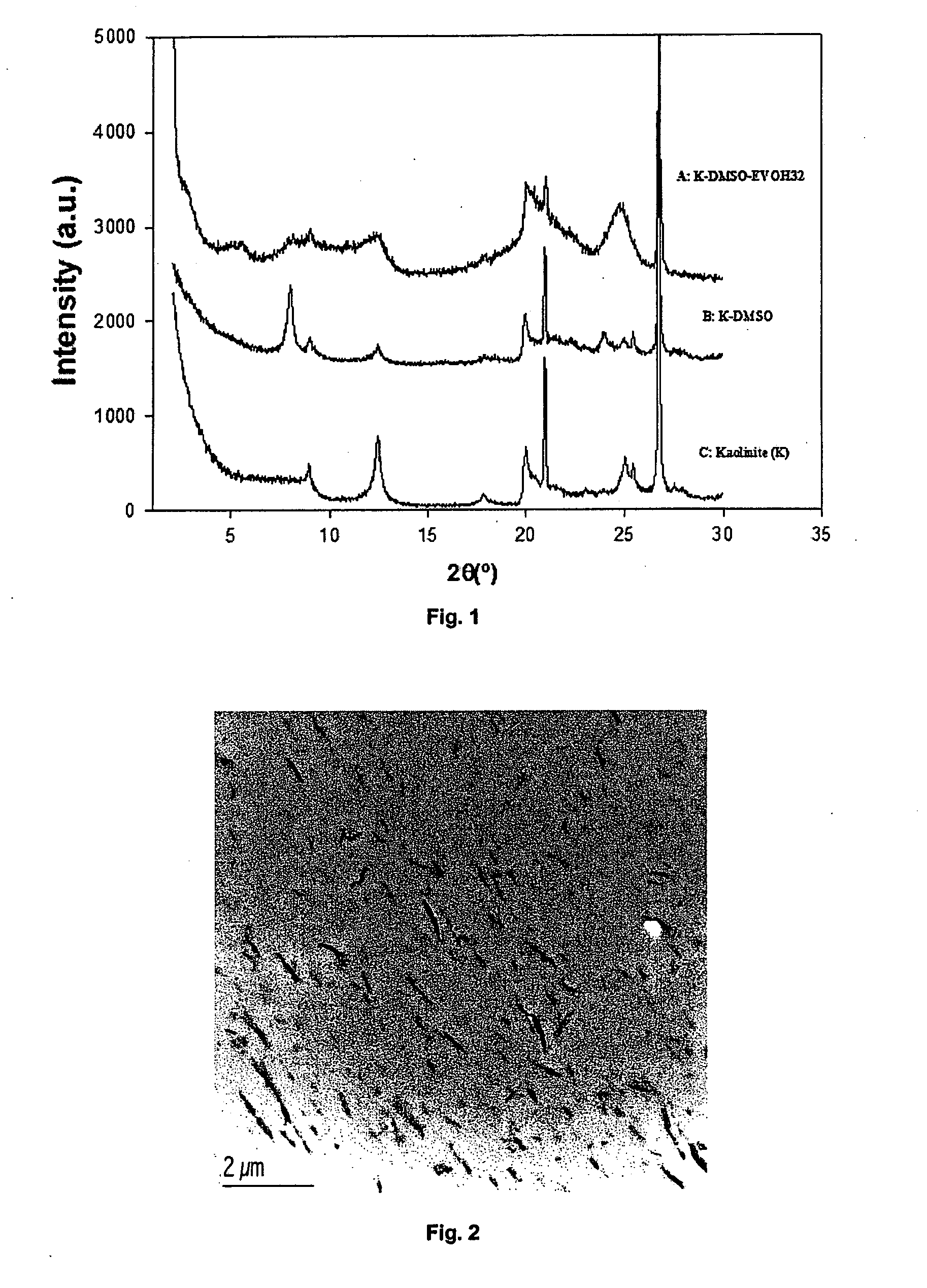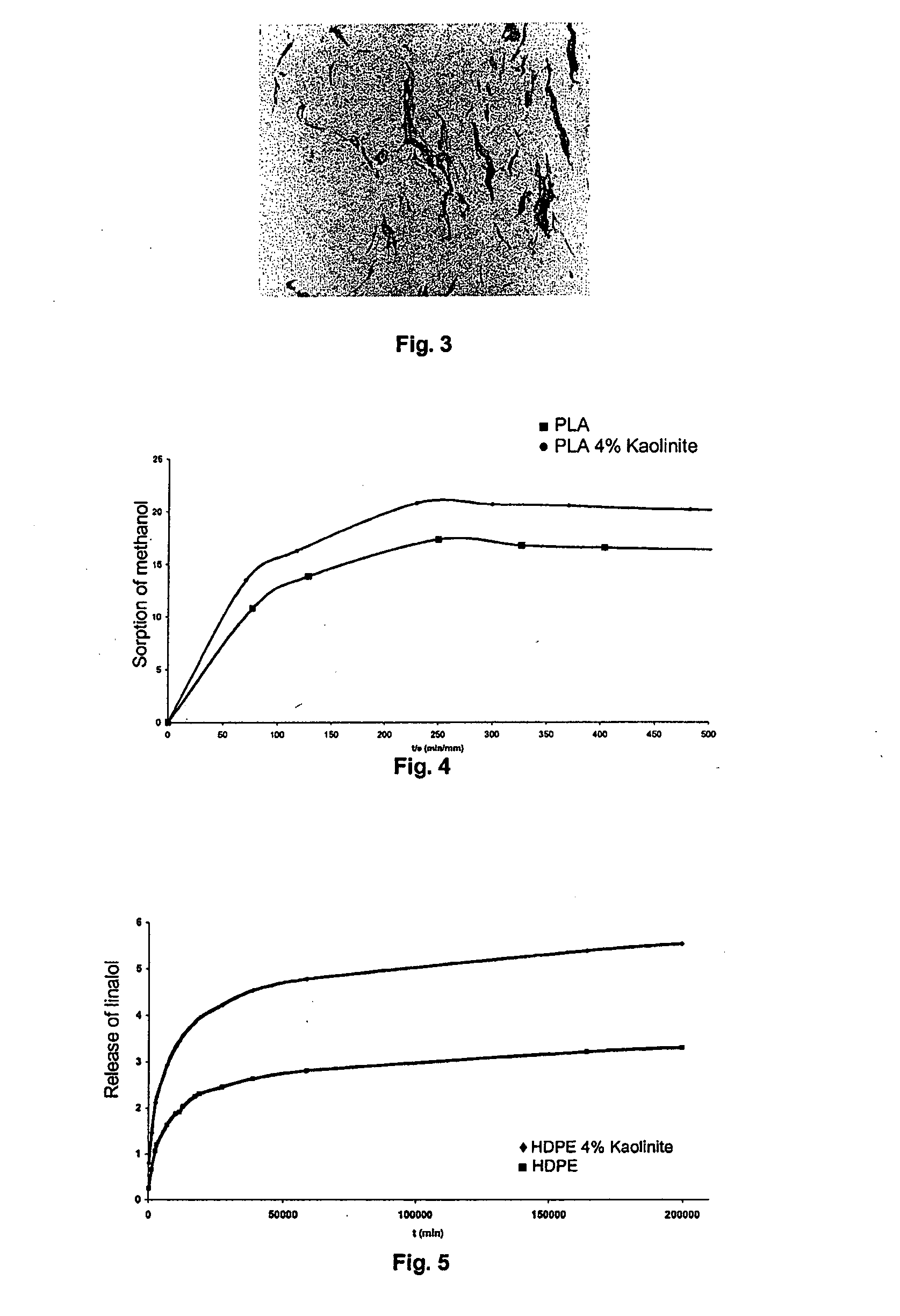Process for manufacturing nanocomposite materials for multisectoral applications
- Summary
- Abstract
- Description
- Claims
- Application Information
AI Technical Summary
Problems solved by technology
Method used
Image
Examples
example 1
EVOH Route
[0017]In this example the modification process consists of a first step in which the purified kaolinite and montmorillonite clay fining agents are pretreated with an ethanol / water 50 / 50 (v / v) mixture at 50° C. This process was carried out together with an ultrasonic stirring treatment process for 1 hour and with stirring with a homogenizer for 2 hours to favor the intercalation of the precursor in the clay. The solvent was then removed by means of lyophilization and / or evaporation. In another example an aqueous solution of DMSO was used as a precursor, an even greater expansion of the clay being obtained as is described in Table 1.
TABLE 1dMODIFIERdMODIFIERMODIFIER(nm)MODIFIER(nm)Unmodified kaolinite0.72Unmodified montmorillonite0.98Dimethyl sulfoxide (DMSO)1.11Polyethylene oxide1.12N-methyl formamide (NMF)1.02Cellulose acetobutyrate1.13Hydrated hydrazine1.03Calcium butyrate0.92Water0.78Sucrose acetoisobutyrate1.08Alcohols1.10Manganese butyrate0.95Anhydrous hydrazine0.96Car...
example 2
[0025]The modification process followed in this example consists of a first modification step of the kaolinite and montmorillonite clay fining agents by means of an aqueous solution treatment of potassium acetate and DMSO as precursors. This process was carried out together with an ultrasonic stirring treatment process for 1 hour at 50° C. and with stirring by means of a homogenizer for 2 hours to favor the intercalation of the precursor in the clay.
[0026]In addition, in one example a chitosan aqueous solution was suspended at 40° C. (100 ml of water and 2 ml of acetic acid were required for every 1 g of chitosan), and in another example soy protein aqueous solution was suspended at 45° C. In both cases, the suspension process was carried out together with an ultrasonic stirring treatment for 1 hour and with stirring by means of a homogenizer for 1 hour.
[0027]The suspension of the clay modified with the precursor was then added in one example to the chitosan aqueous ...
example 3
[0034]The modification process followed in this example consists of a first modification step of the kaolinite and montmorillonite clay fining agents by means of a treatment with a solution of DMSO as a precursor. This process was carried out together with an ultrasonic stirring treatment process for 1 hour at 50° C. and with stirring by means of a homogenizer for 2 hours to favor the intercalation of the precursor in the clay. The solvent was then removed by a lyophilization and / or evaporation process to give rise to a powdered product.
[0035]In a second step, the clay is again suspended in a hexadecyltrimethylammonium bromide (C16) aqueous solution in the presence of ultrasonic stirring and a homogenizer at 50° C. for 4 hours or in a chitosan solution as described above. The solvent was then removed by a lyophilization and / or evaporation process to give rise to a powdered product.
[0036]The modified clay is added in powder form to a melt mixing process with HDPE (BP ...
PUM
| Property | Measurement | Unit |
|---|---|---|
| Fraction | aaaaa | aaaaa |
| Fraction | aaaaa | aaaaa |
| Percent by volume | aaaaa | aaaaa |
Abstract
Description
Claims
Application Information
 Login to view more
Login to view more - R&D Engineer
- R&D Manager
- IP Professional
- Industry Leading Data Capabilities
- Powerful AI technology
- Patent DNA Extraction
Browse by: Latest US Patents, China's latest patents, Technical Efficacy Thesaurus, Application Domain, Technology Topic.
© 2024 PatSnap. All rights reserved.Legal|Privacy policy|Modern Slavery Act Transparency Statement|Sitemap


